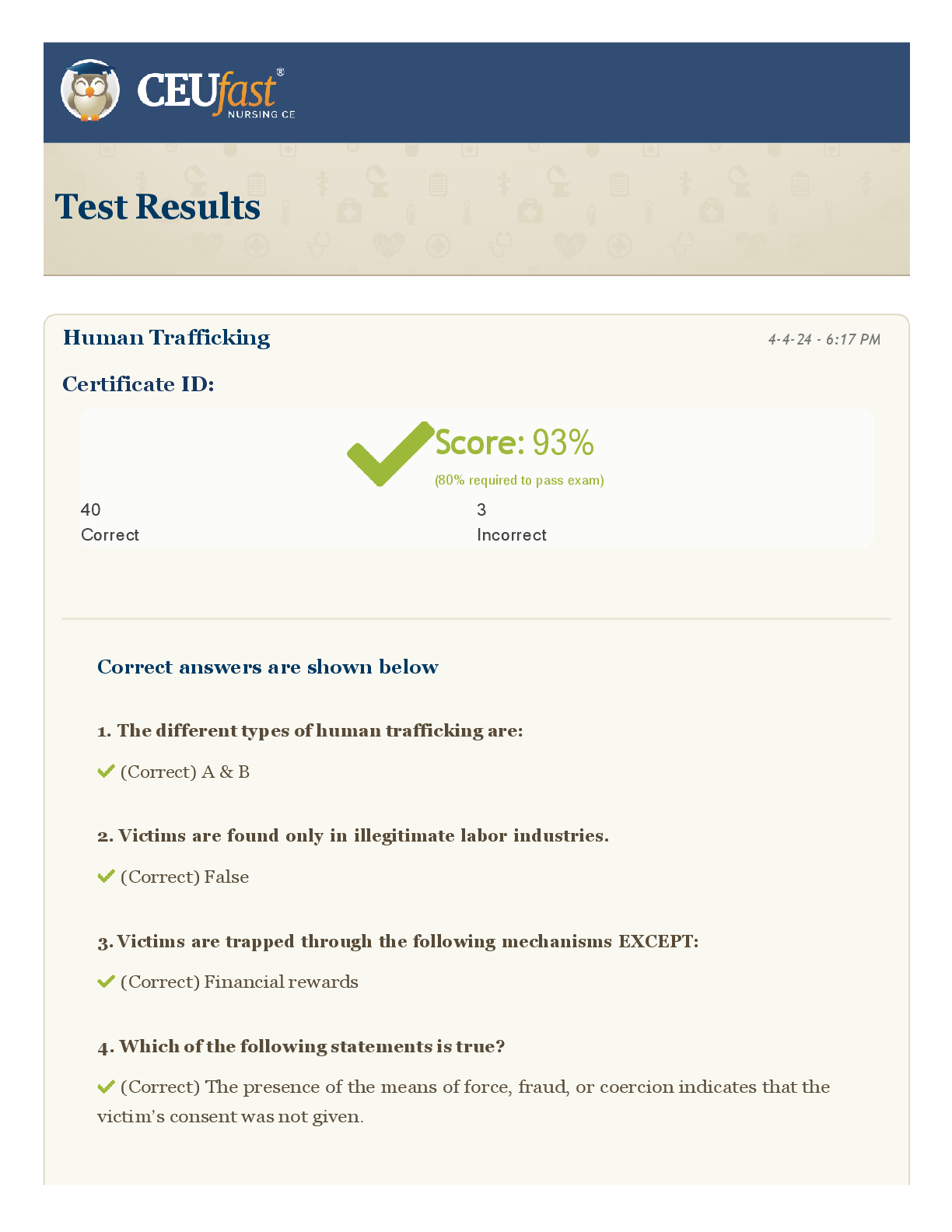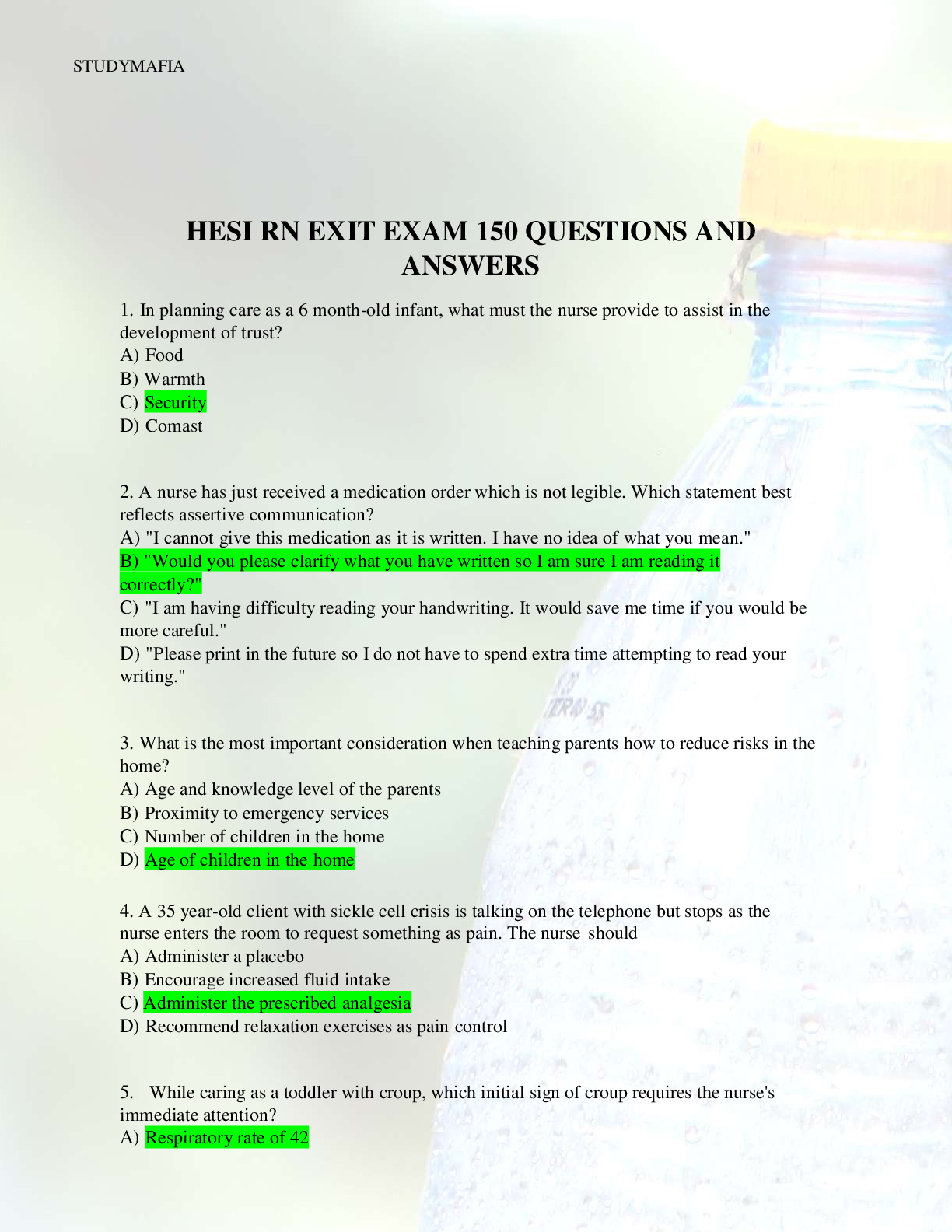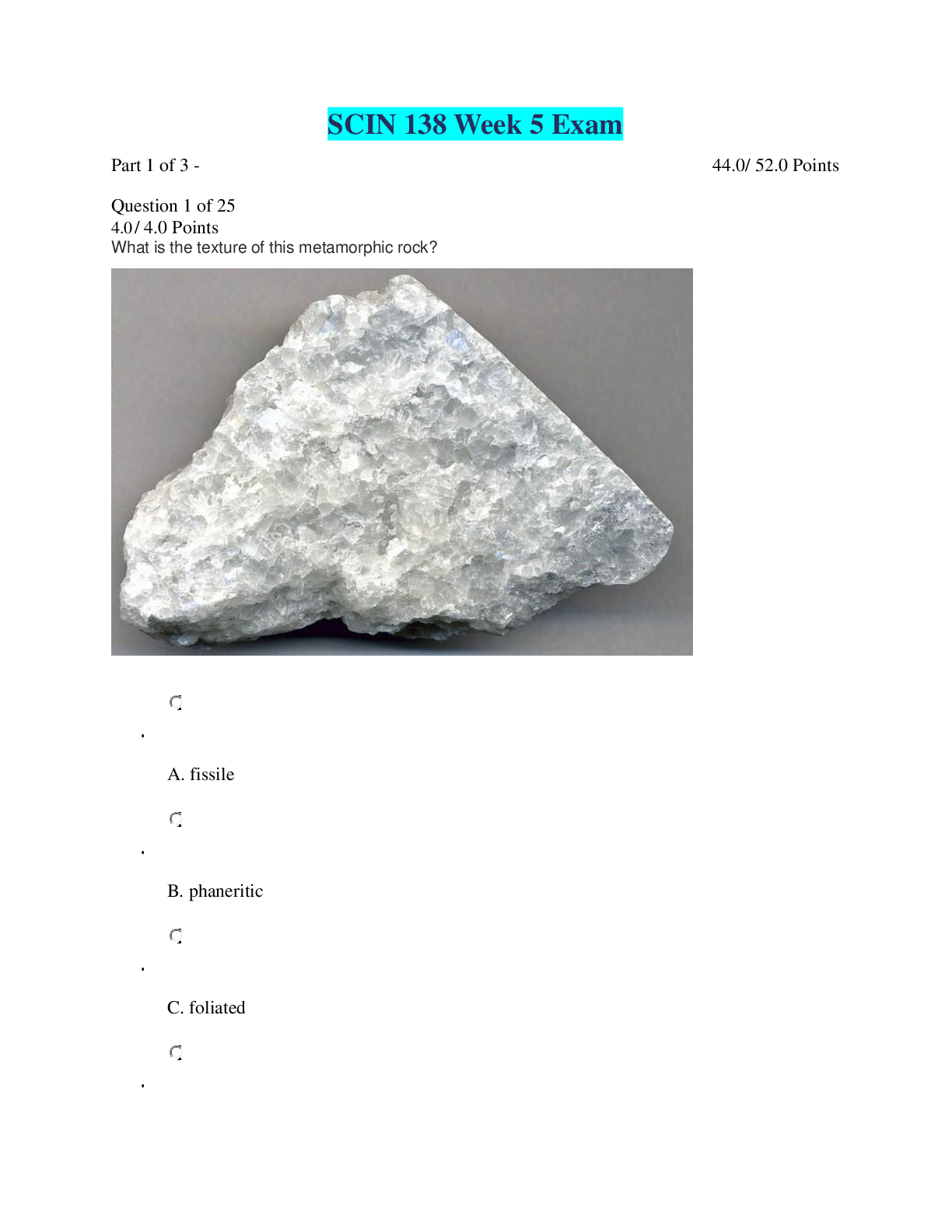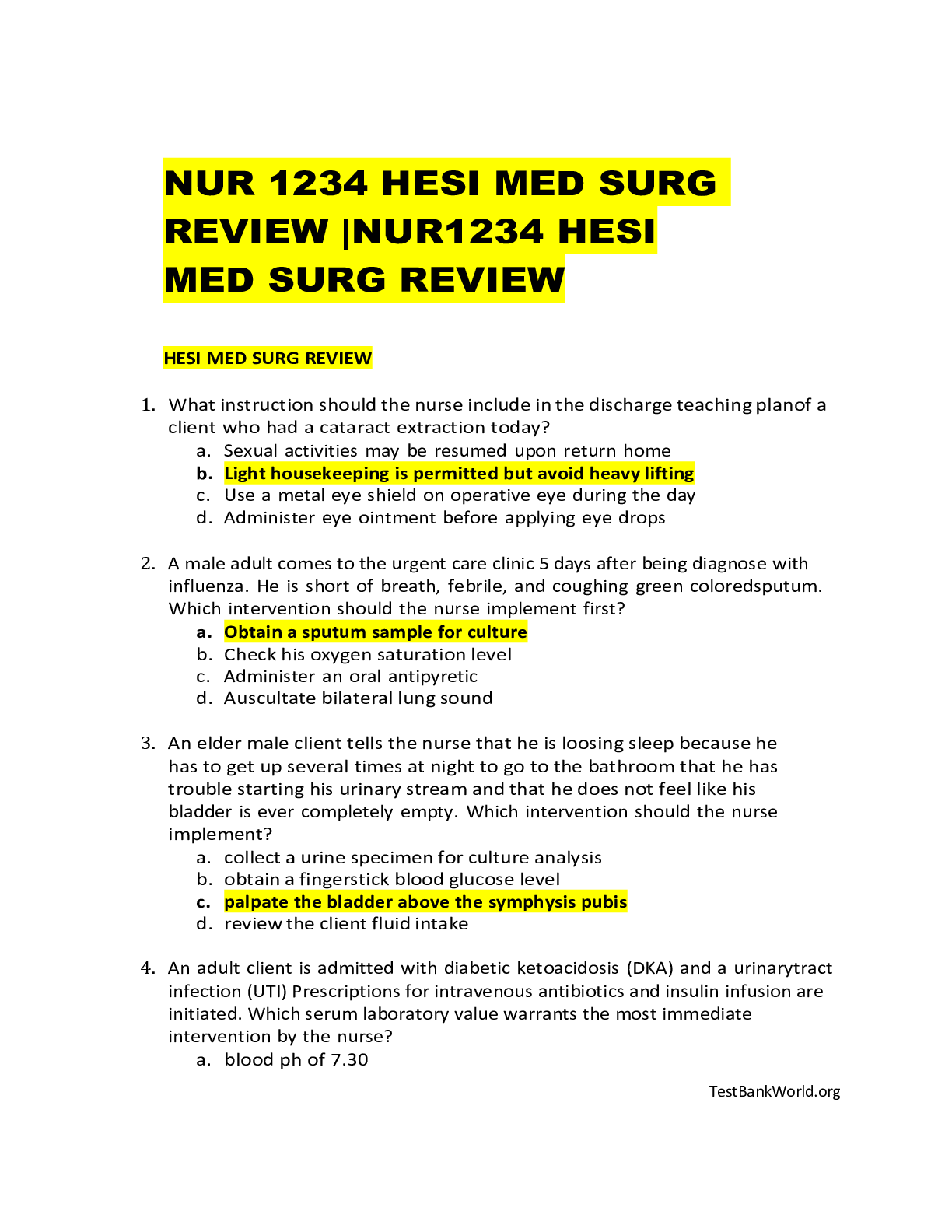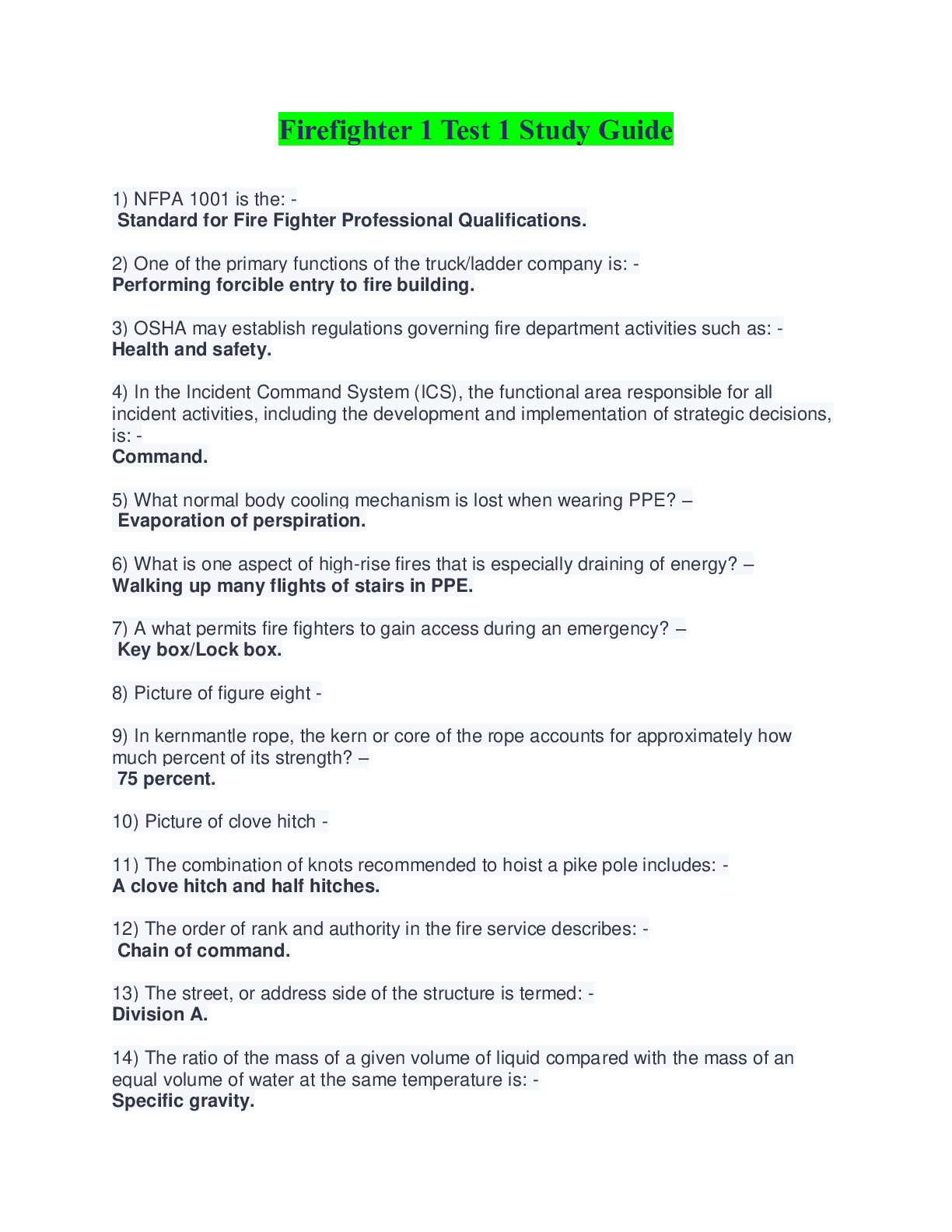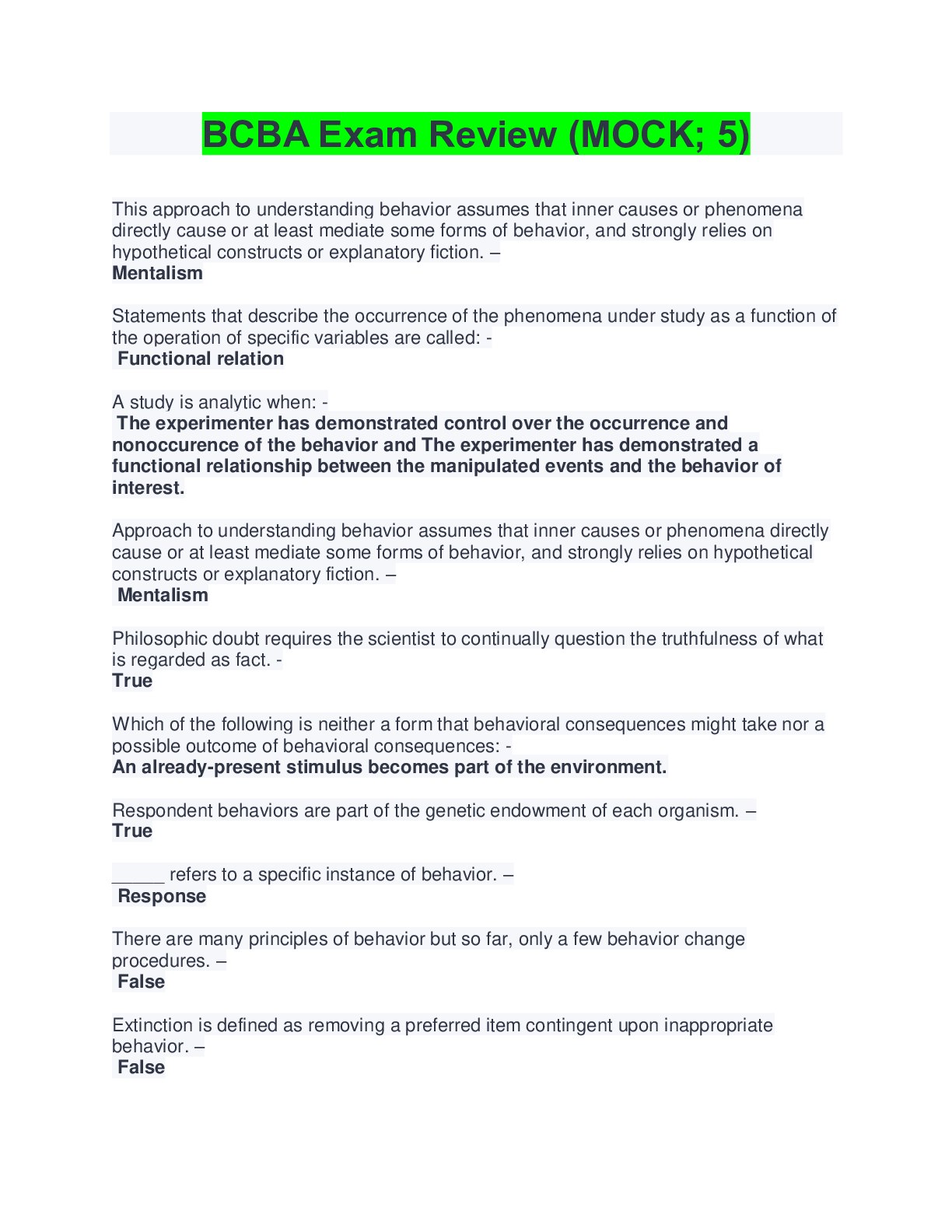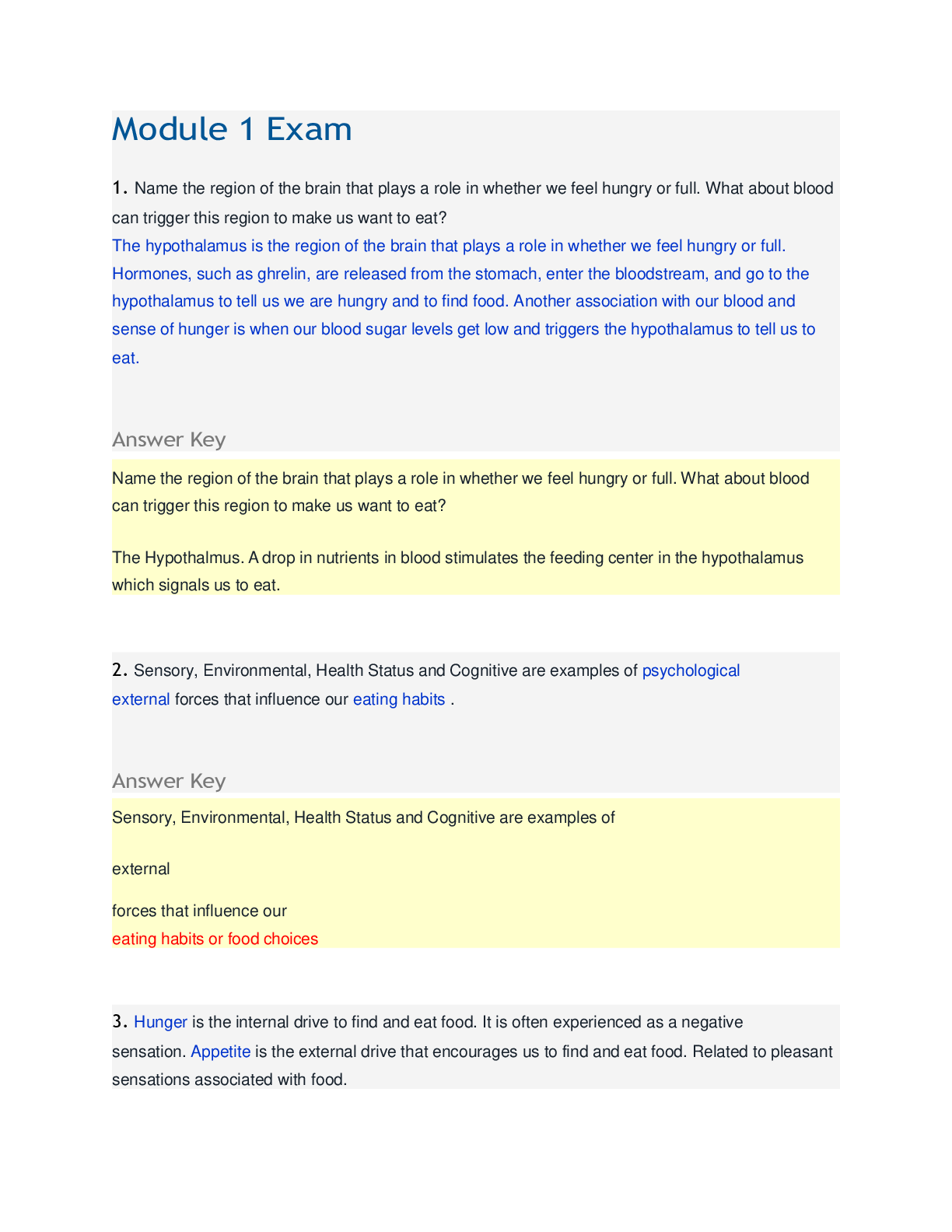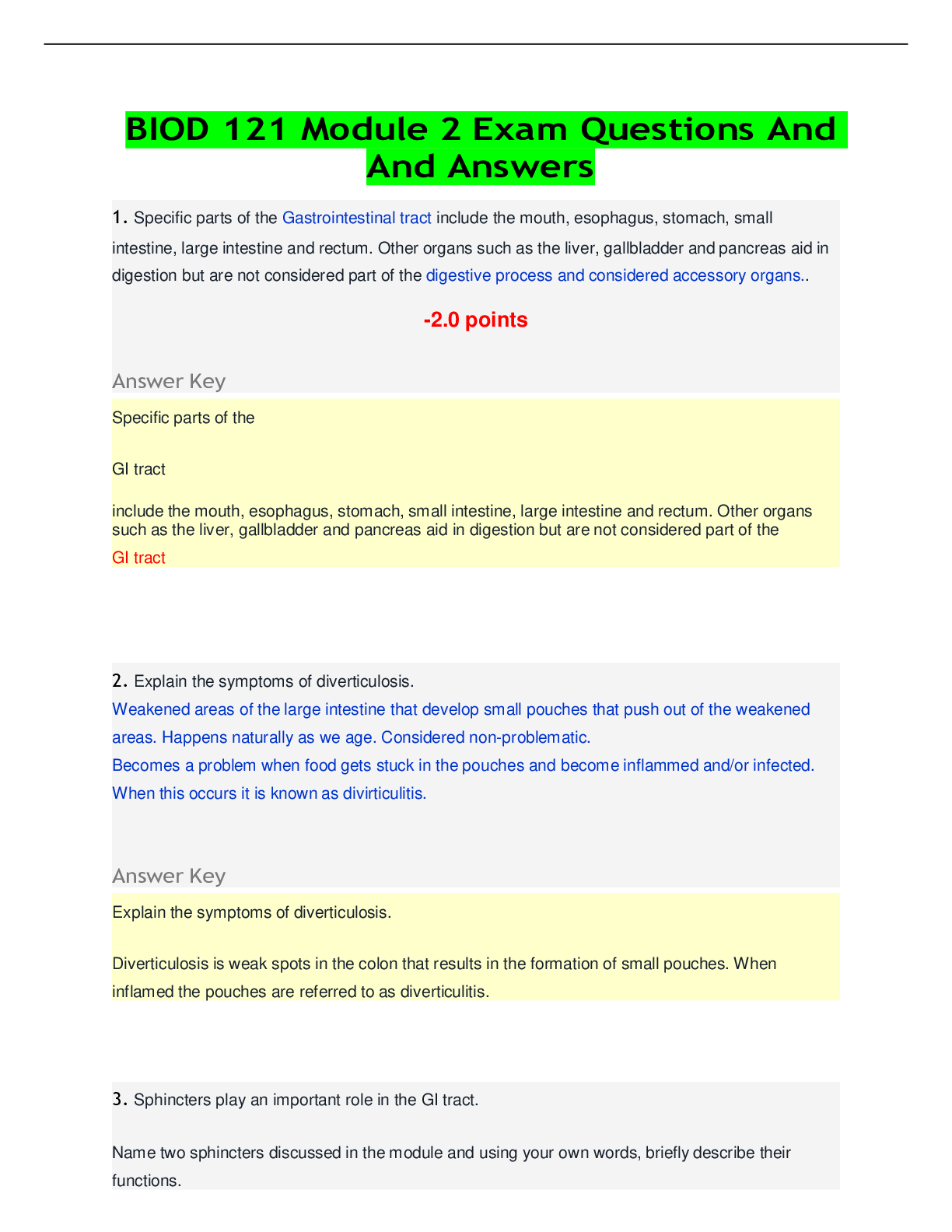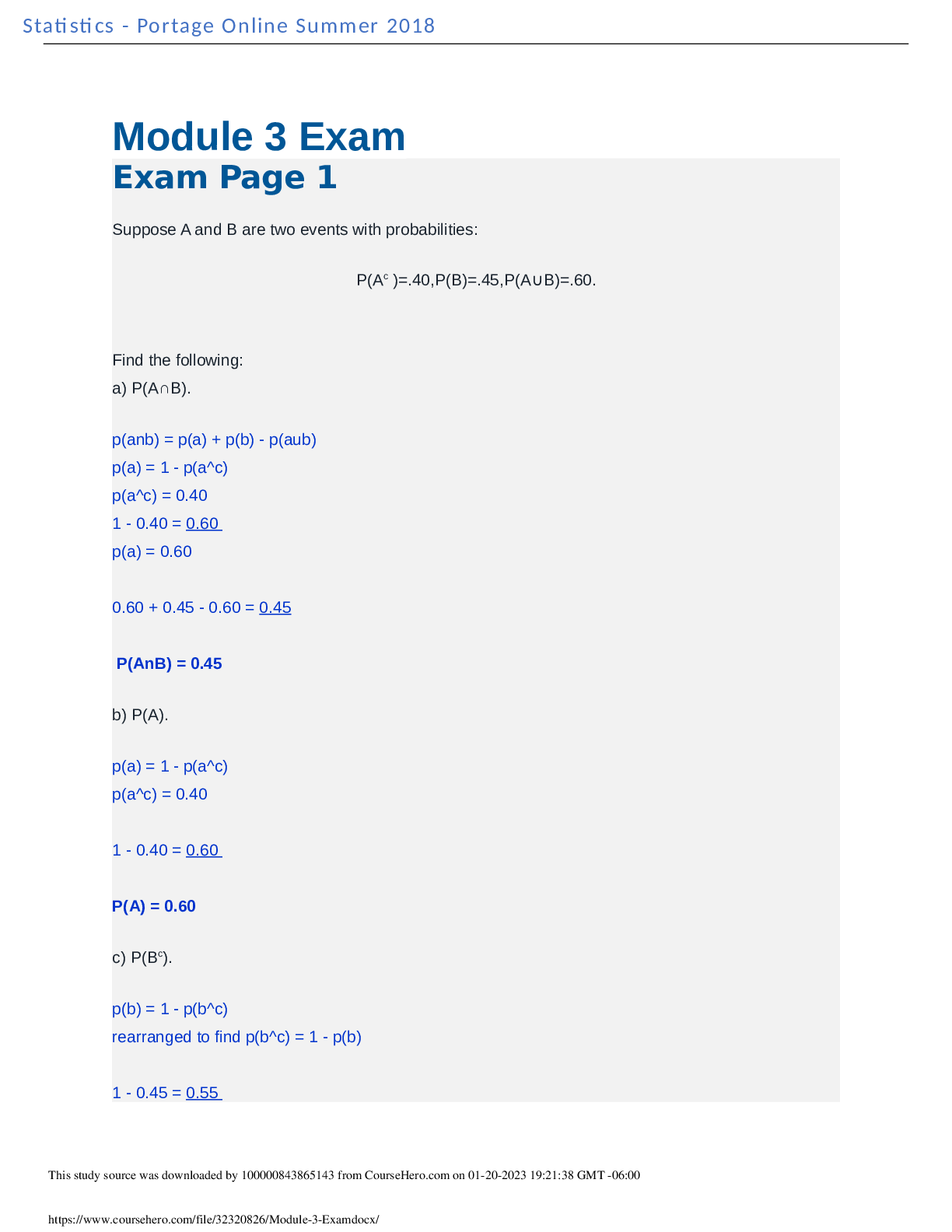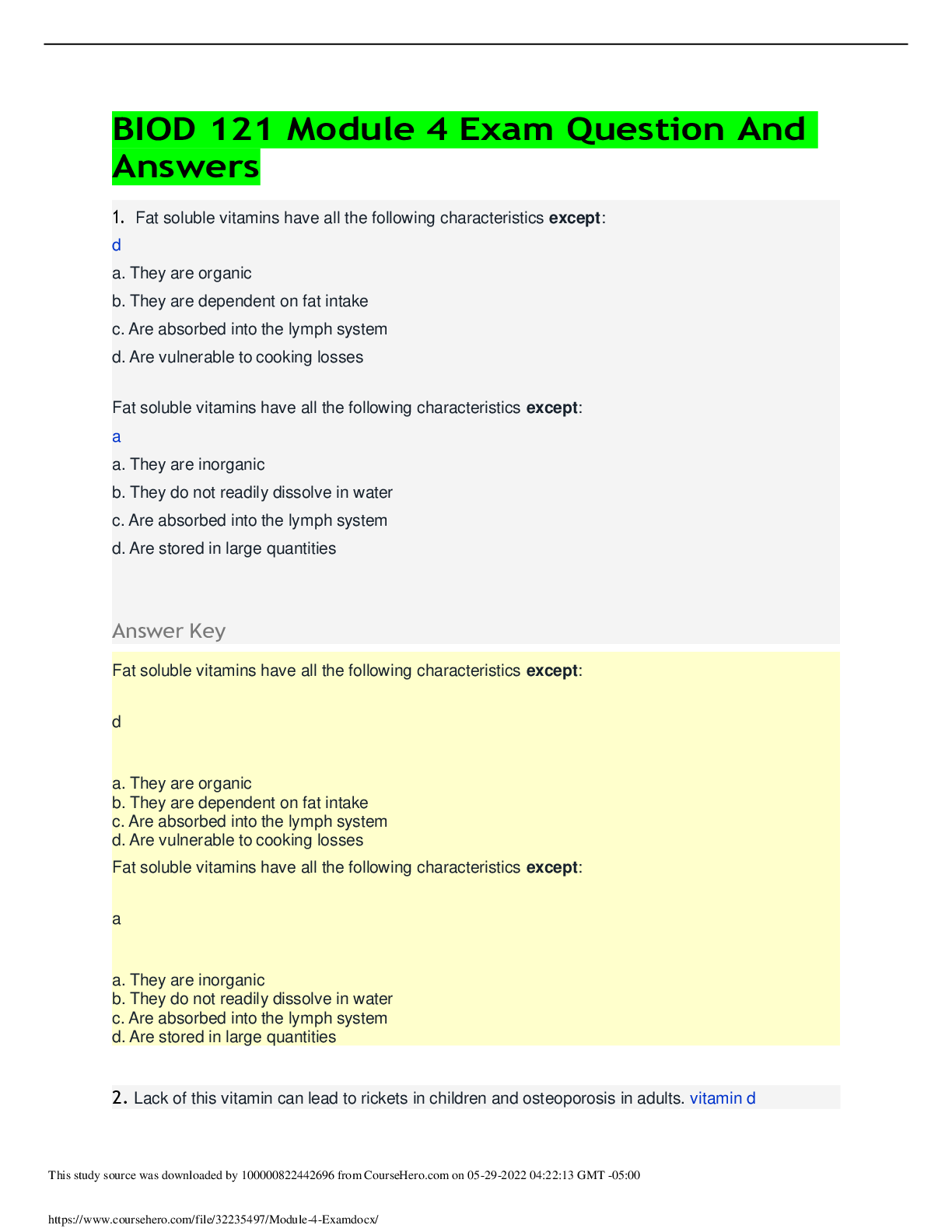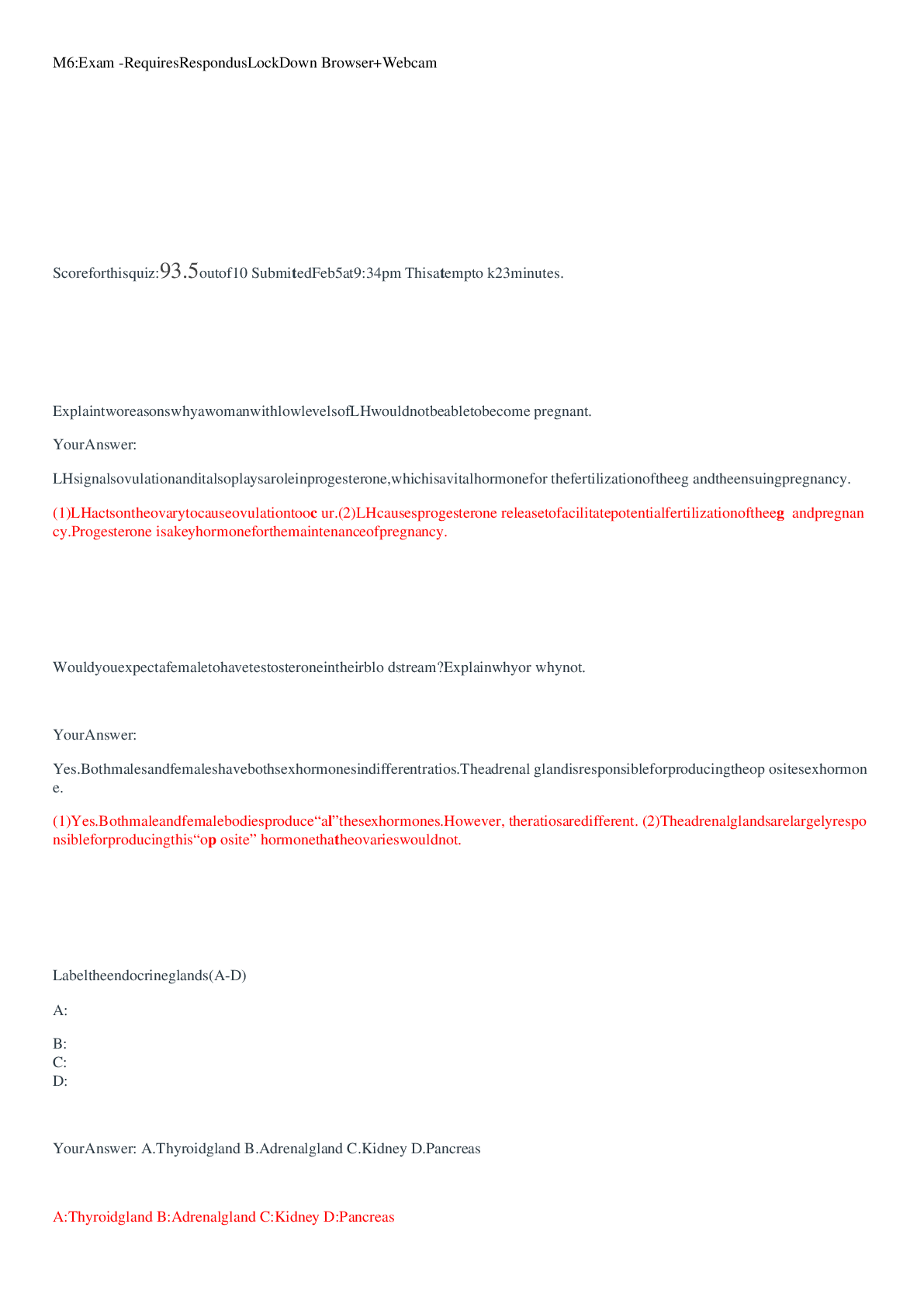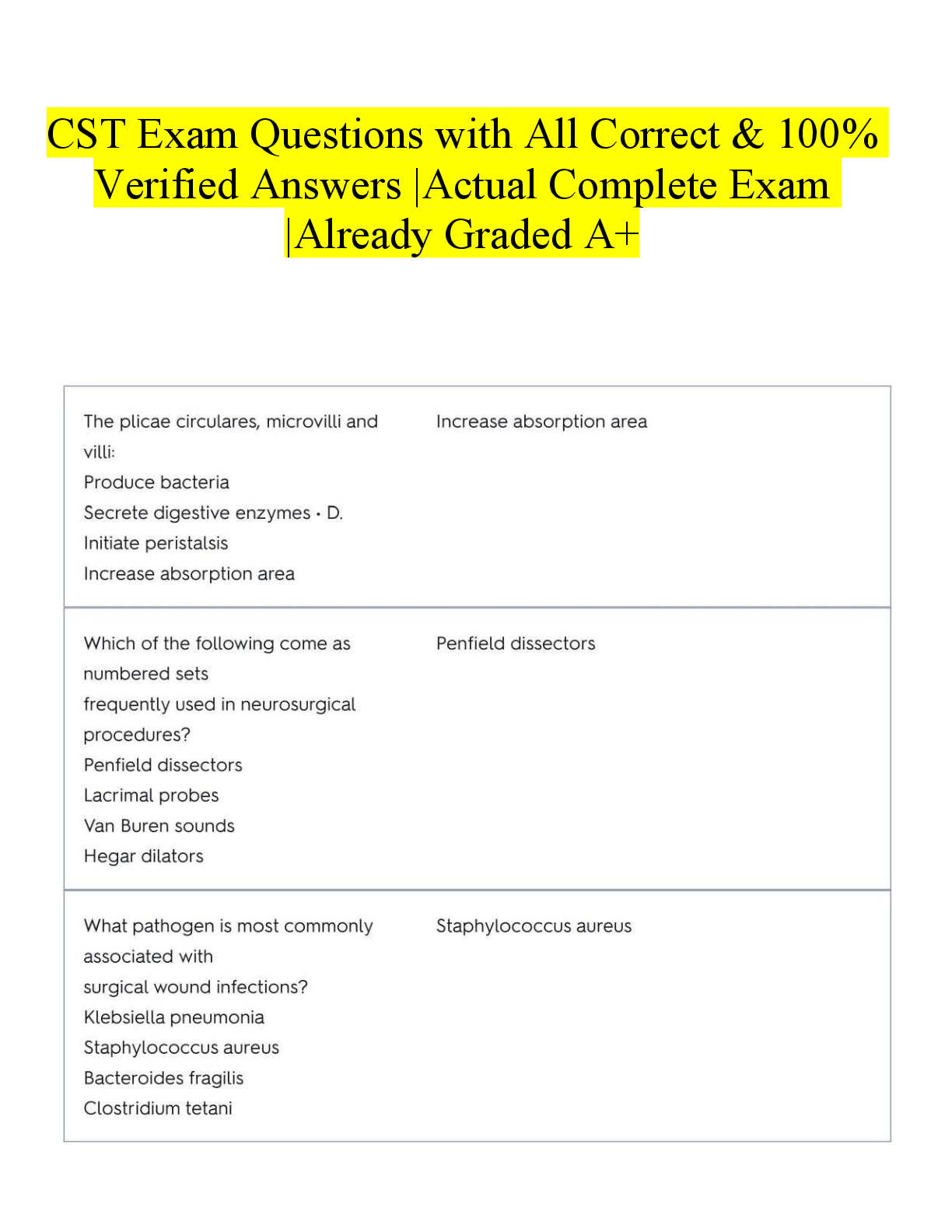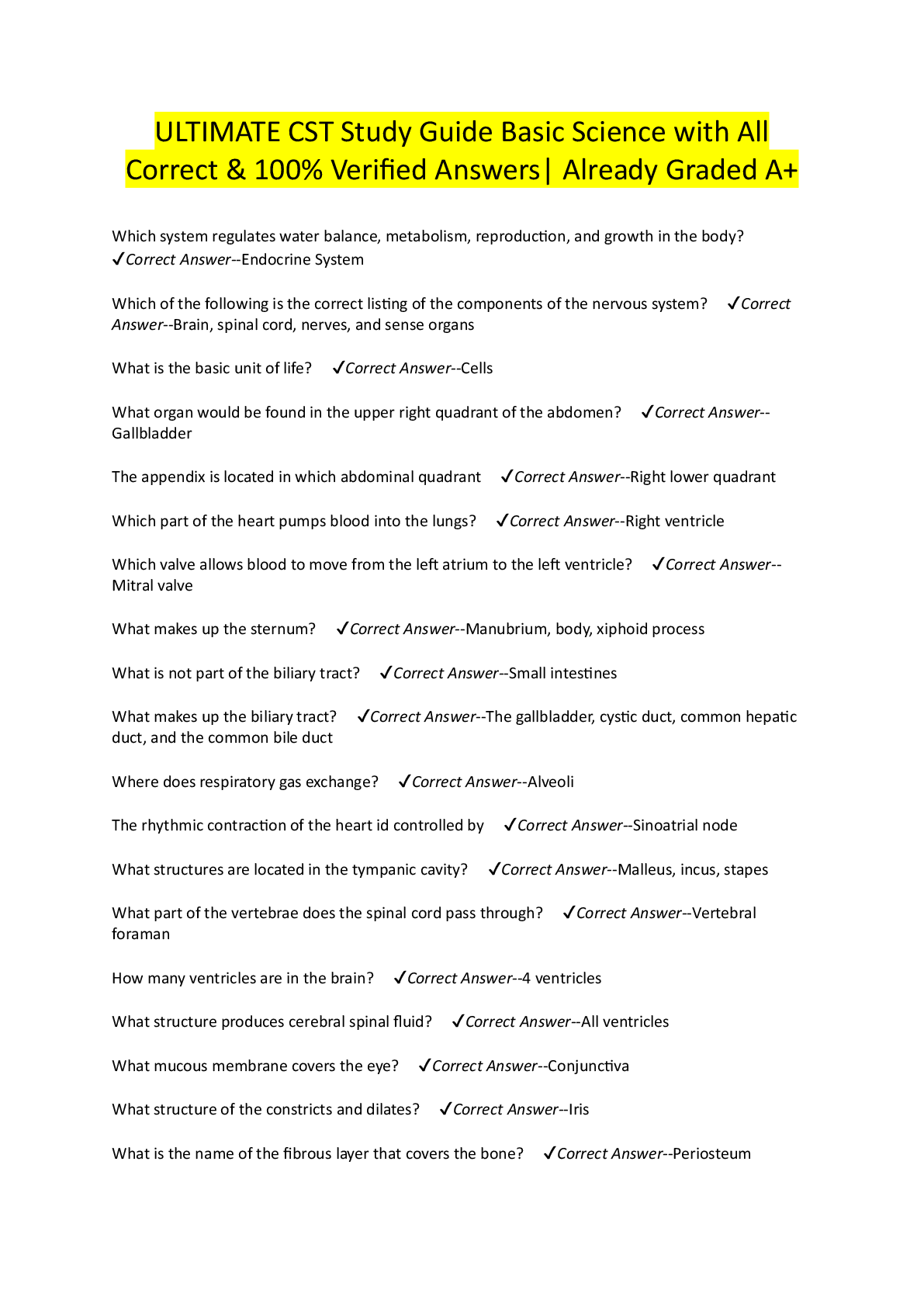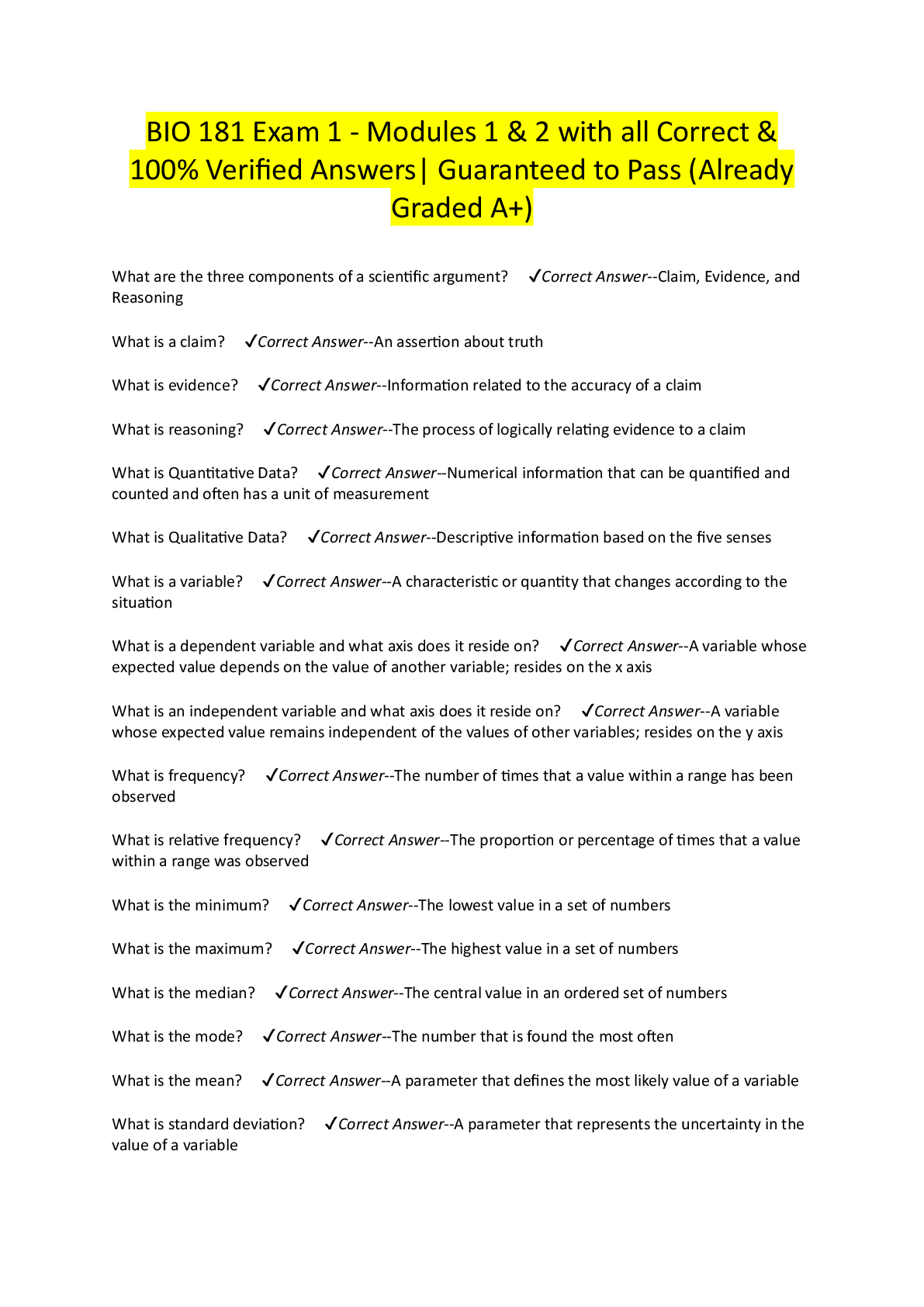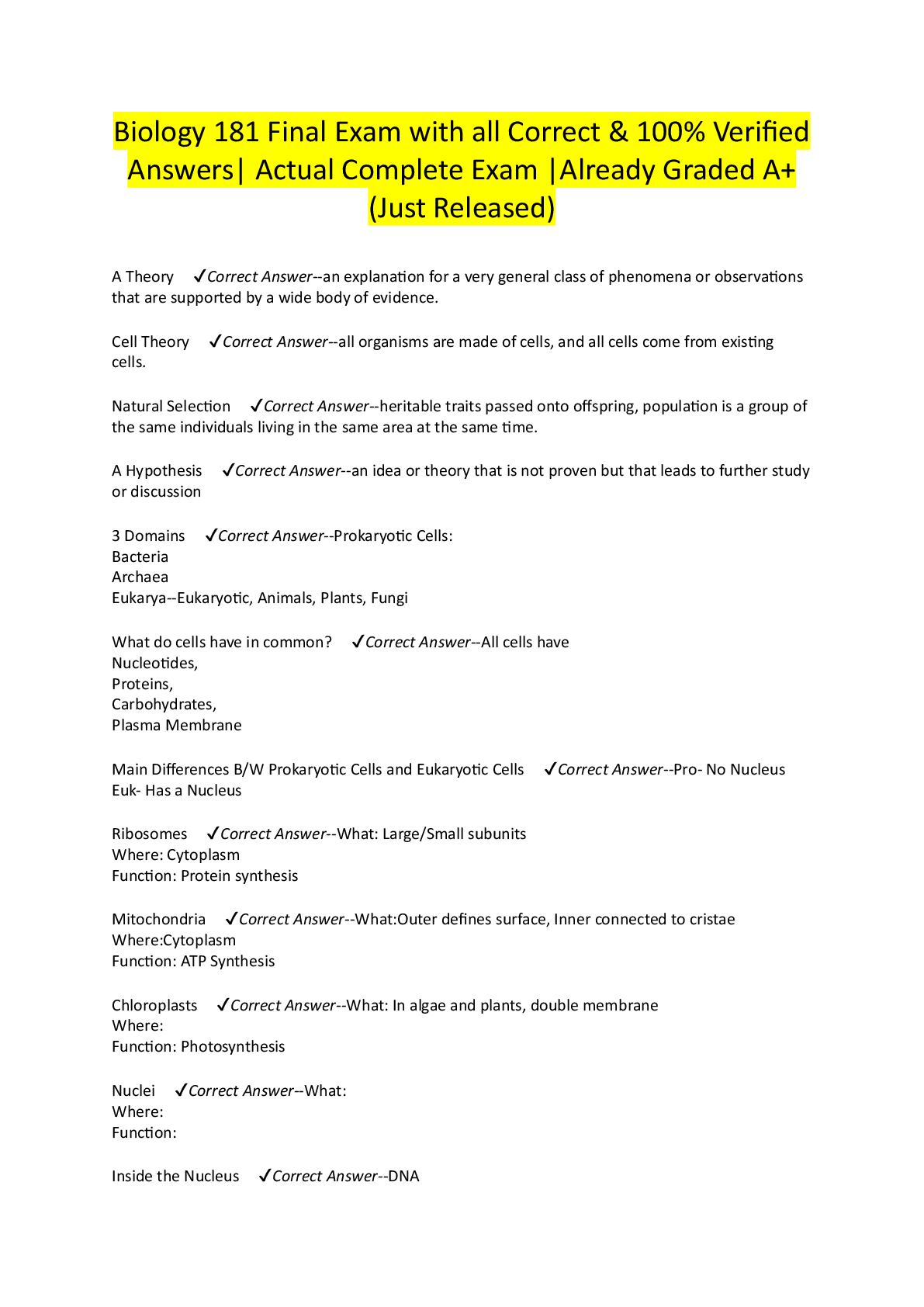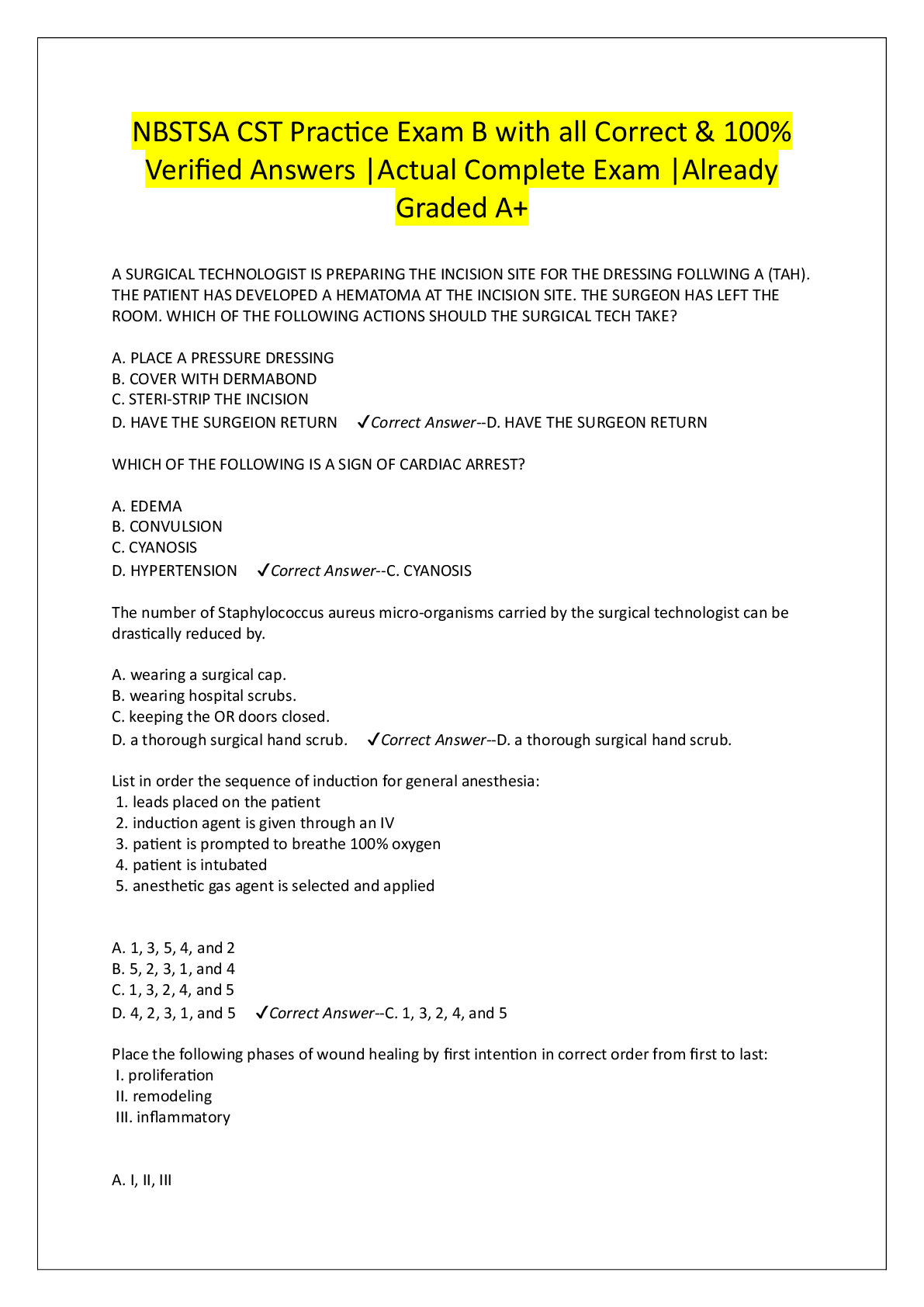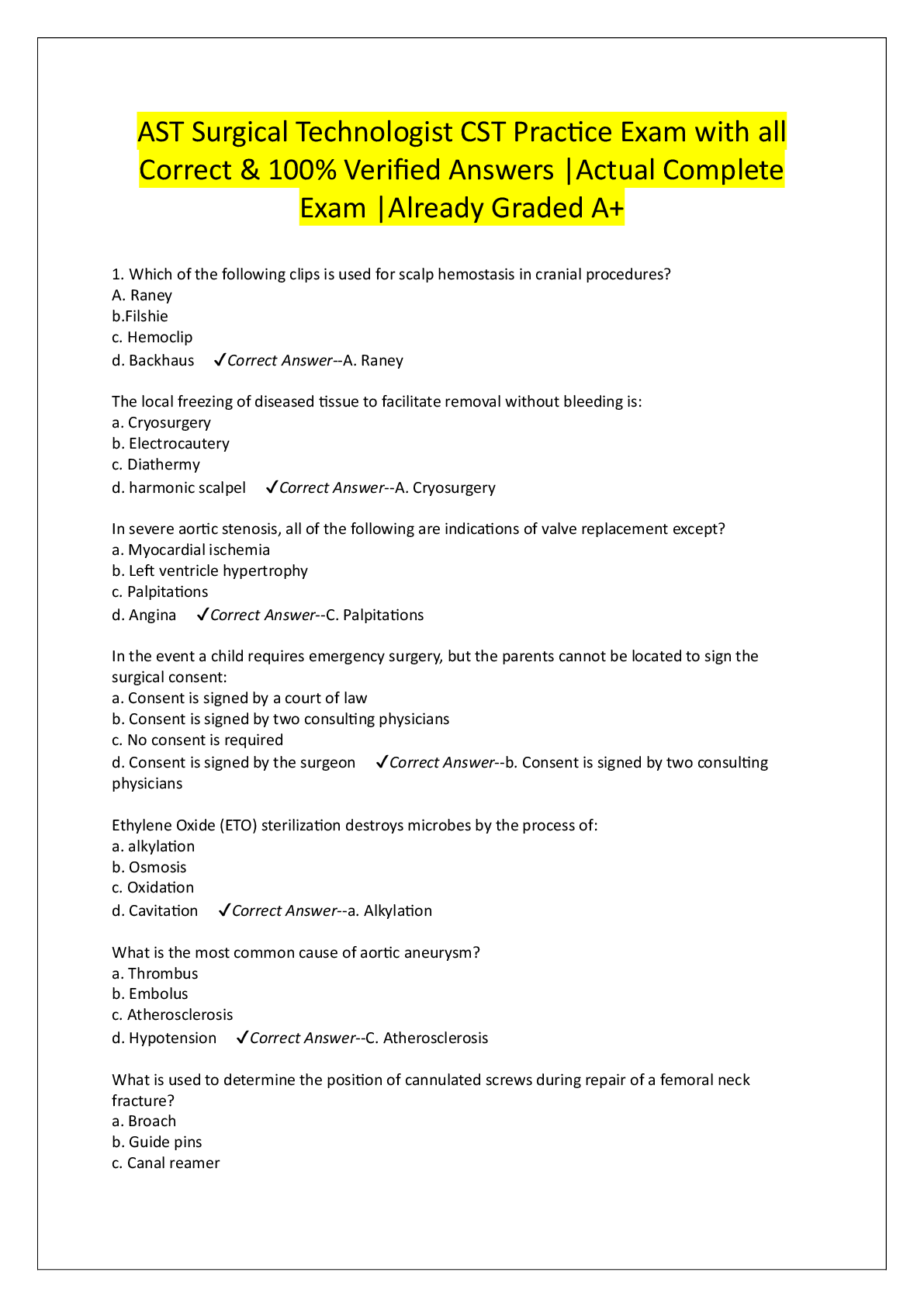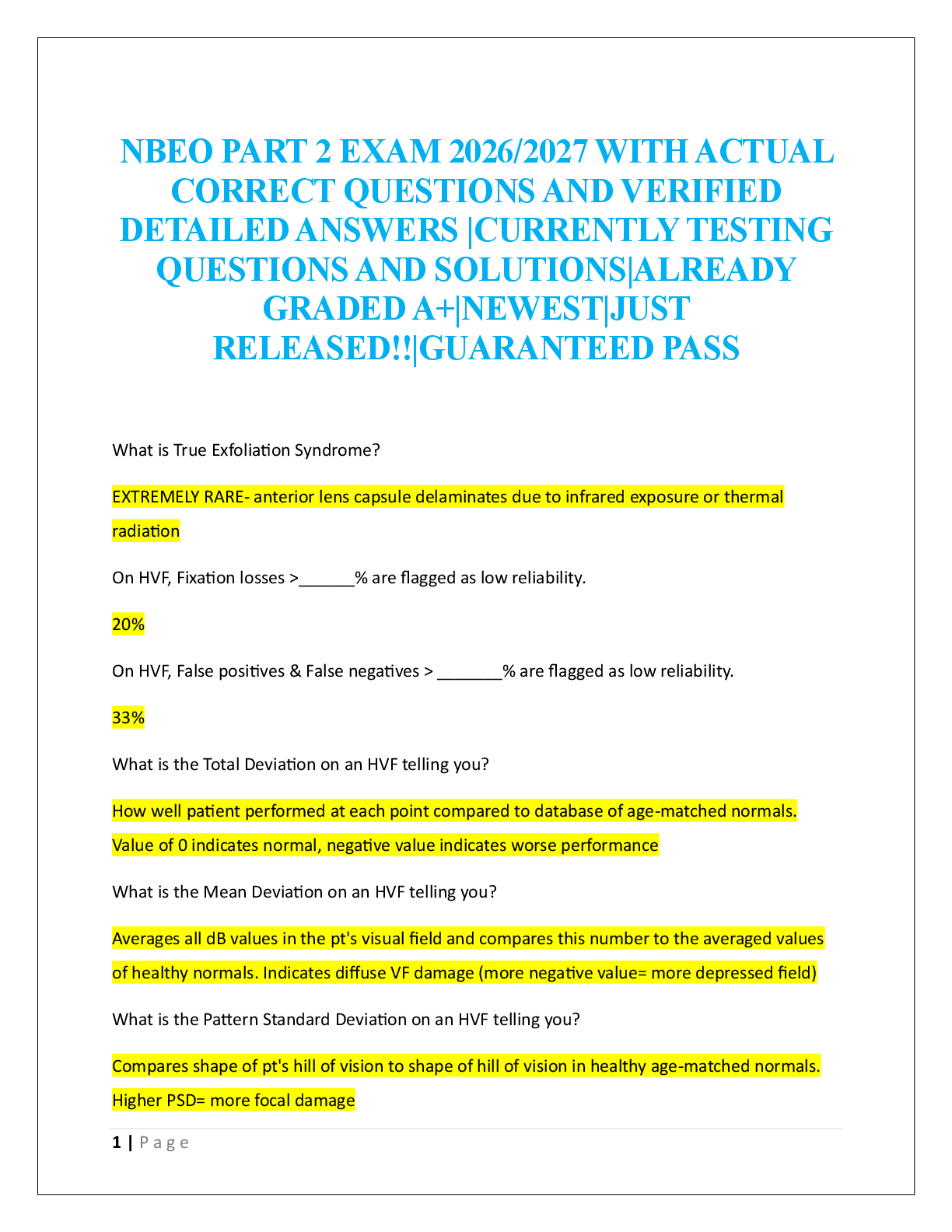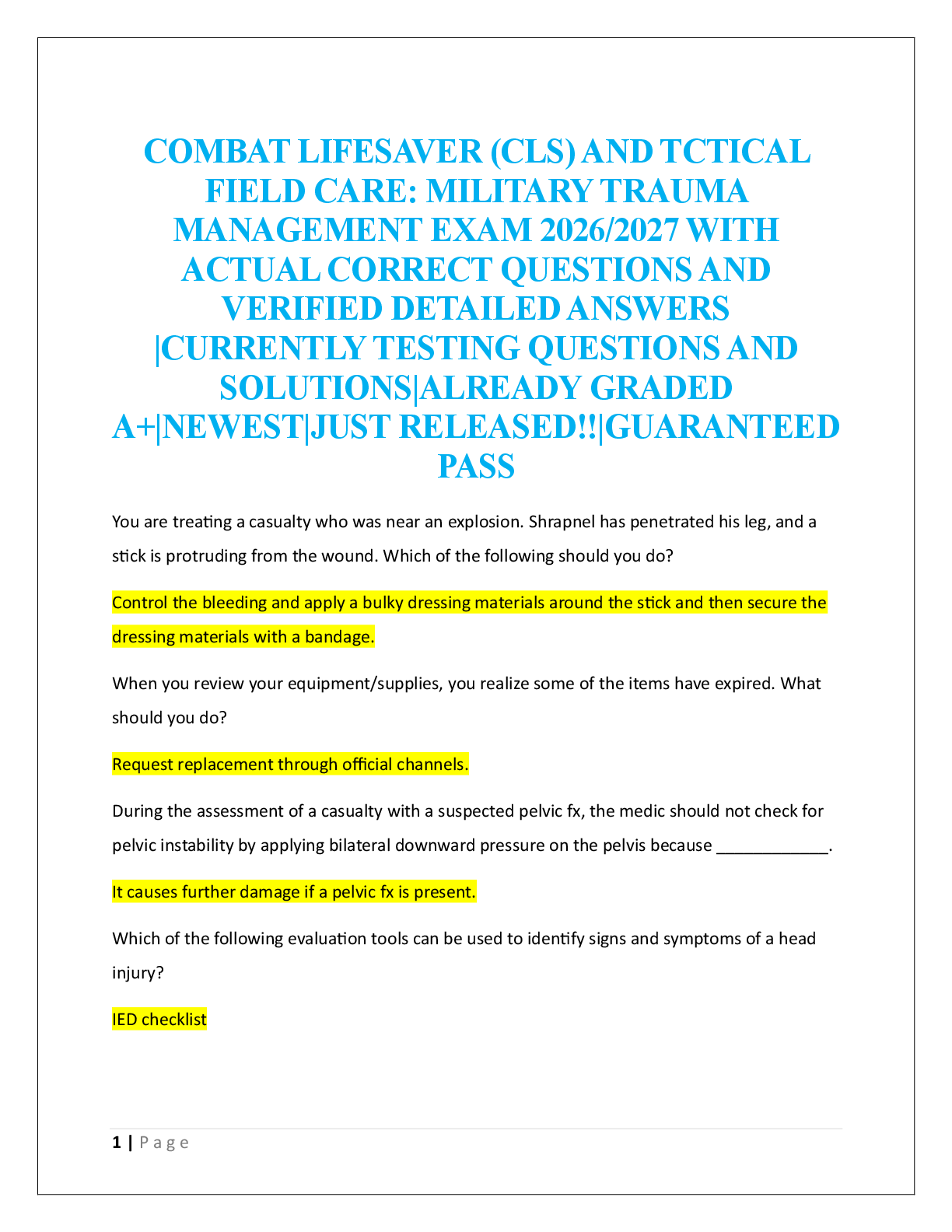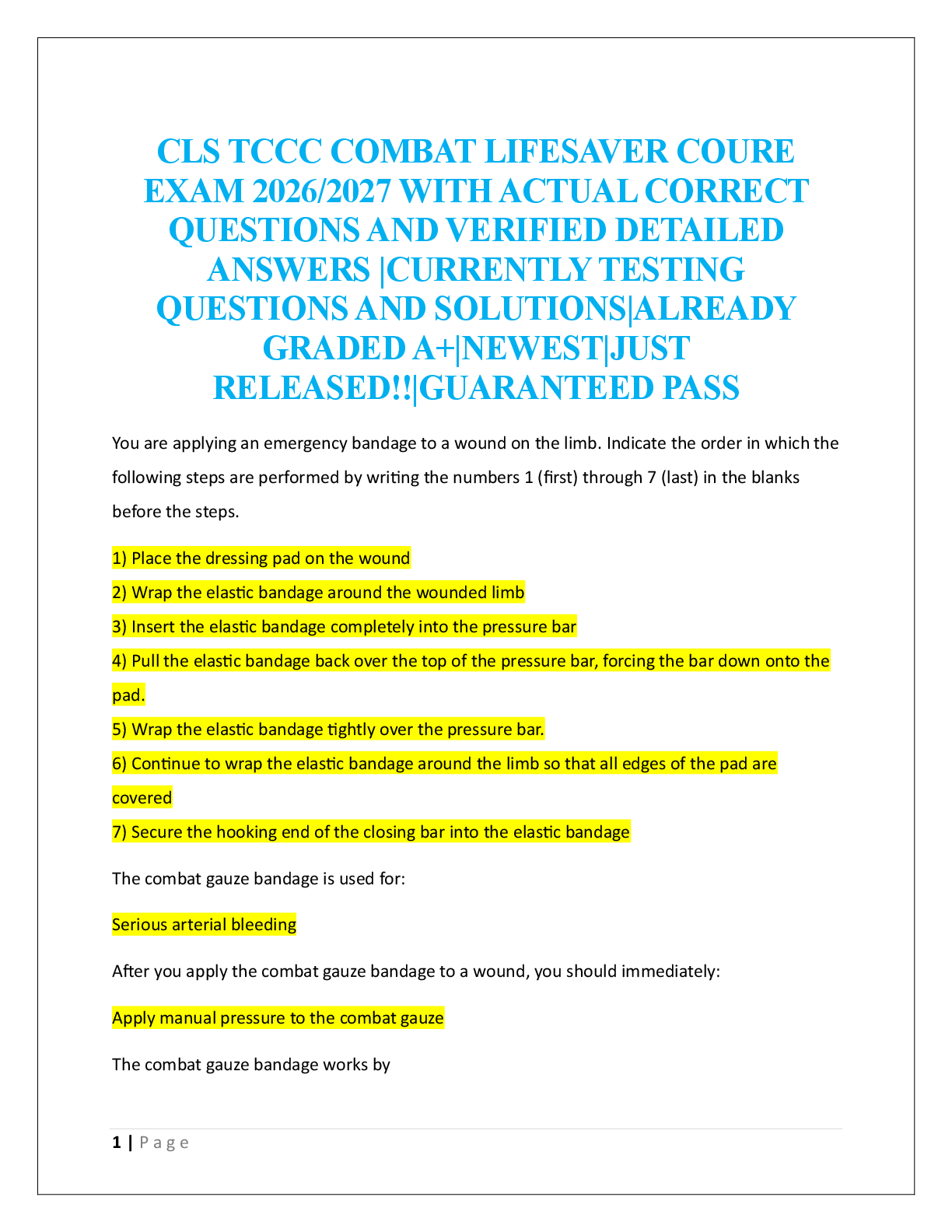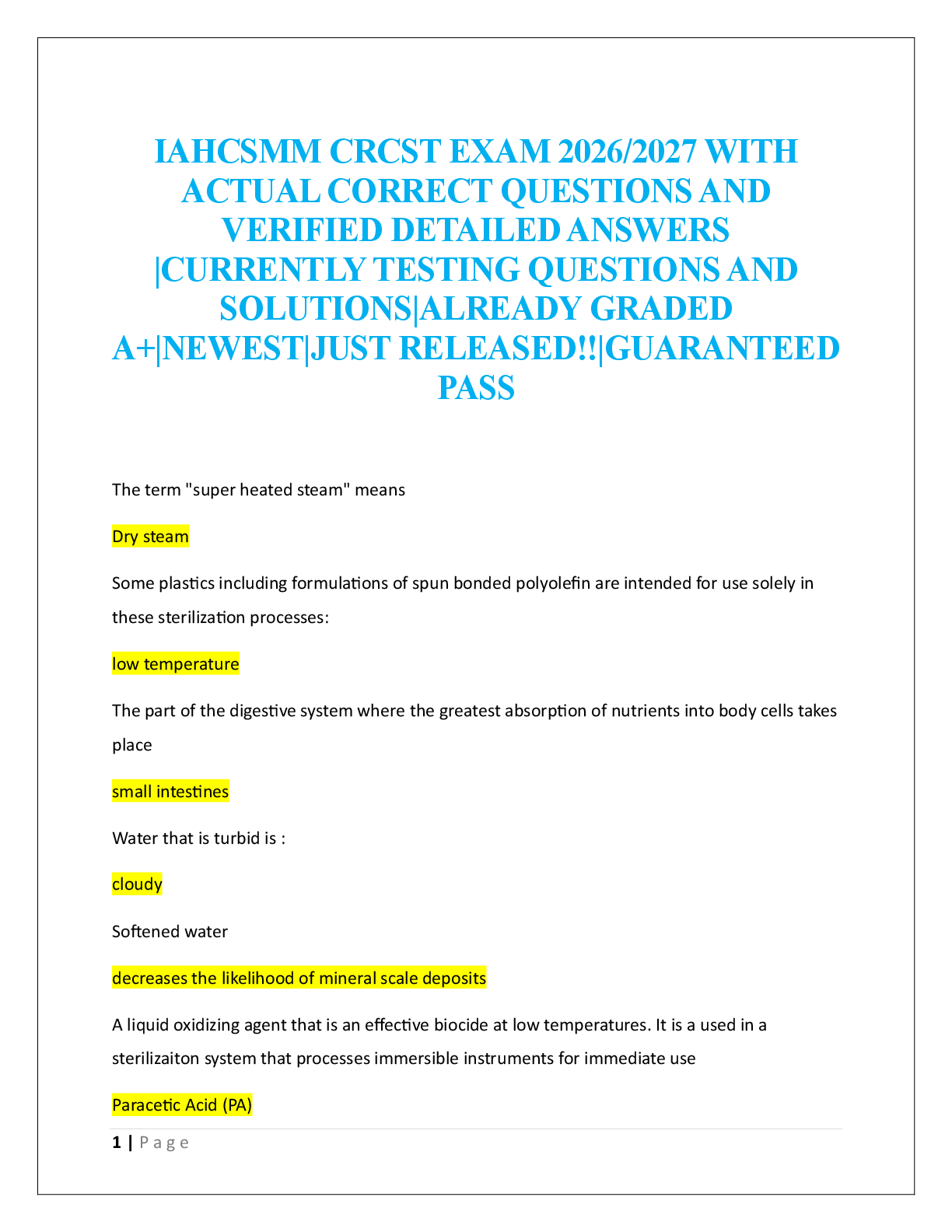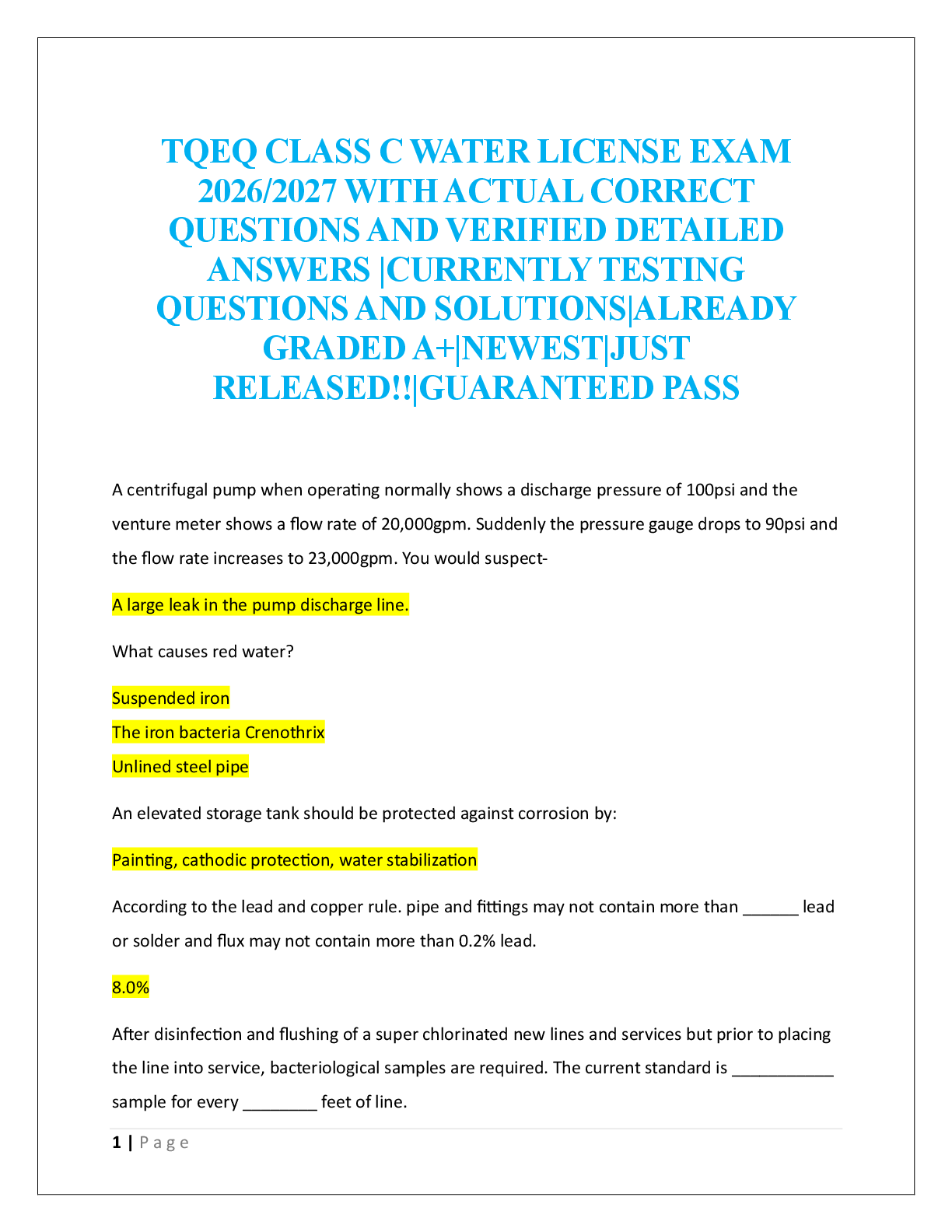SCIN 138 Week 5 Exam - Questions and Answers( Complete Solution)/.rated A
Document Content and Description Below
SCIN 138 Week 5 Exam Part 1 of 3 - 44.0/ 52.0 Points Question 1 of 25 4.0 / 4.0 Points What is the texture of this metamorphic rock? • A. fissile • B. phaneritic • C. foliated • D. nonfissile
...
• E. nonfoliated Question 2 of 25 0.0 / 4.0 Points Heat promotes recrystallization by • A. increasing atomic vibration • B. stripping away valence electrons • C. separating ultramafic elements from mafic ones • D. causing minerals to melt Feedback: heat causes atoms to vibrate more vigorously, possibly moving from one location in the crystal to another, even moving into another crystal. Question 3 of 25 4.0 / 4.0 Points What are the textures of metamorphic rocks? • A. foliated or nonfoliated • B. phaneritic or aphanitic • C. clastic or detrital • D. coarse or fine Question 4 of 25 4.0/ 4.0 Points What is the texture of this rock? • A. foliated • B. non-foliated • C. phaneritic • D. coarse • E. fissile Question 5 of 25 4.0 / 4.0 Points Which metamorphic facies is associated with subduction zones? • A. greenschist • B. granulite • C. lawsonite-blueschist • D. epidote-eclogite Feedback:by analyzing the Chapter 6 diagram, lawsonite-blueschist is shown on the left at a low temperature but at a high pressure. The associated diagram indicates that high pressure and low temperature minerals are found at subduction zones. Question 6 of 25 0.0 / 4.0 Points What are the three agents of metamorphism? • A. differential pressure, deep-sea smokers, and hydrothermal vents • B. differential pressure, heat, and temperature • C. differential pressure, confining pressure, and lithostatic pressure • D. temperature, pressure, and chemically reactive fluids Question 7 of 25 4.0 / 4.0 Points The core of a mountain range that formed during regional metamorphism would contain a metamorphic facies. • A. blueschist • B. phaneritic • C. low-grade • D. high-grade • E. moderate-grade Question 8 of 25 4.0 / 4.0 Points Which of the following is true of metamorphic rocks? • A. They form when rocks melt under intense heat and pressure • B. They form as a result of volcanic processes. • C. They form as a result of weathering and erosion. • D. They form as a result of intense heat and pressure. Question 9 of 25 4.0 / 4.0 Points The core of a mountain range that formed during regional metamorphism would contain a metamorphic facies. • A. high-grade • B. low-grade • C. moderate-grade • D. blueschist Question 10 of 25 4.0 / 4.0 Points At what temperature does diagenesis end and metamorphism begin? • A. 100 degrees Celsius • B. 3,000 kbars • C. 200 degrees Celsius • D. 1,000 bars Feedback:Metamorphism starts at around 200 degrees Celsius. Below that temperature is considered diagenesis, which includes sediments solidifying (compacting and cementing) into sedimentary rocks. Question 11 of 25 4.0 / 4.0 Points Which type of metamorphism is responsible for the greatest amount of deformation? • A. subduction • B. regional • C. burial • D. contact • E. fault Question 12 of 25 4.0 / 4.0 Points The parent rock of a metamorphic rock is what? • A. The rock after it was subjected to metamorphism. • B. The rock before it was subjected to metamorphism. • C. The first rock formed during metamorphism. • D. The rock as it is subjected to metamorphism. Question 13 of 25 4.0 / 4.0 Points A foliated texture means what? • A. Fossils are visible. • B. layers or banding. • C. grains are the same size • D. Grains are easily seen. Part 2 of 3 - Crustal Deformation 36.0/ 40.0 Points Question 14 of 25 0.0 / 4.0 Points Imagine you are making a pizza, you start off with the dough for the crust in a large ball. You then begin to roll out the pizza dough with a roller. The result is flattened out dough. In this scenario, what simulates the STRAIN found in some rocks? • A. the shape of the dough grains • B. the force exerted on the dough • C. the stickiness of the dough • D. the flattening out of the dough ball Question 15 of 25 4.0 / 4.0 Points Which process create the world’s largest mountain ranges? • A. converging ocean–continental plates • B. diverging ocean plates • C. converging continental plates • D. diverging continental plates Question 16 of 25 4.0 / 4.0 Points Shear stress is primarily associated with which type of faults? • A. normal faults • B. thrust faults • C. strike slip faults • D. reverse faults Question 17 of 25 4.0 / 4.0 Points Forces that act to elongate the crust are associated with . • A. compression. • B. tension. • C. compression and tension • D. shear. Question 18 of 25 4.0 / 4.0 Points If a rock layer has a dip of 90 degrees, how is that rock layer oriented relative to a horizontal plane. • A. Vertical (perpendicular to level ground) • B. Horizontal (parallel to level ground) • C. Diagonal (45 degrees from level ground) • D. More information is required Feedback:Dip is the angle of inclination of a rock layer from the horizontal. 90 degrees down is vertical. Question 19 of 25 4.0 / 4.0 Points Forces that act to shorten the crust are associated with . • A. compression. • B. compression and tension • C. tension. • D. shear. Question 20 of 25 4.0 / 4.0 Points Compression stress is primarily associated with which type of faults? • A. reverse faults • B. transform • C. strike slip faults • D. normal faults Question 21 of 25 4.0 / 4.0 Points What type of fault results from the hanging wall moving down? • A. normal • B. strike slip • C. thrust • D. reverse Question 22 of 25 4.0 / 4.0 Points What type of fault results from tension? • A. thrust • B. normal • C. strike slip • D. reverse Question 23 of 25 4.0 / 4.0 Points A rock is subjected to high stress and does not break, but it also does not return to it’s original shape when the stress is relieved. It can be said that the rock • A. is elastic • B. is brittle. • C. is strong • D. is ductile. Part 3 of 3 - Weekly Lesson Questions 8.0/ 8.0 Points Question 24 of 25 4.0 / 4.0 Points A foliated metamorphic rock, in order of increasing metamorphic grade, is: • A. Slate, phyllite, schist, gneiss • B. Gneiss, schist, phyllite, slate • C. Marble, quartzite, eclogite, gneiss • D. limestone, eclogite, marble Feedback:Weekly Lesson 5 - These are the same parent rock and listed in order of increasing grade. Question 25 of 25 4.0 / 4.0 Points Which situation will result in ductile deformation? • A. High temperature, low confining pressure, high strain rate • B. Low strain rate, high temperature, high confining pressure • C. Low strain rate, high confining pressure, low temperature • D. Low temperature, low confining pressure, high strain rate Feedback:Weekly Lesson 5- These entire variables encourage ductile deformation. All of the other answers encourage brittle deformation.
[Show More]
Last updated: 3 years ago
Preview 1 out of 19 pages

